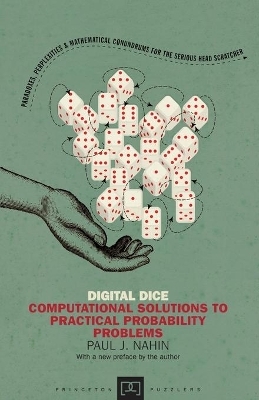
Digital Dice
Princeton University Press (Verlag)
978-0-691-15821-1 (ISBN)
Readers learn, for example, not just how to determine the optimal stopping point in any selection process but that astronomer Johannes Kepler selected his second wife by interviewing eleven women. The book shows readers how to write elementary computer codes using any common programming language, and provides solutions and line-by-line walk-throughs of a MATLAB code for each problem. Digital Dice will appeal to anyone who enjoys popular math or computer science. In a new preface, Nahin wittily addresses some of the responses he received to the first edition.
Paul J. Nahin is the author of many best-selling popular-math books, including Chases and Escapes, Dr. Euler's Fabulous Formula, When Least is Best, Duelling Idiots and Other Probability Puzzlers, and An Imaginary Tale (all Princeton). He is professor emeritus of electrical engineering at the University of New Hampshire.
Preface to the Paperback Edition xiii Introduction 1 The Problems 35 1. The Clumsy Dishwasher Problem 37 2. Will Lil and Bill Meet at the Malt Shop? 38 3. A Parallel Parking Question 40 4. A Curious Coin-Flipping Game 42 5. The Gamow-Stern Elevator Puzzle 45 6. Steve's Elevator Problem 48 7. The Pipe Smoker's Discovery 51 8. A Toilet Paper Dilemma 53 9. The Forgetful Burglar Problem 59 10. The Umbrella Quandary 61 11. The Case of the Missing Senators 63 12. How Many Runners in a Marathon? 65 13. A Police Patrol Problem 69 14. Parrondo's Paradox 74 15. How Long Is the Wait to Get the Potato Salad? 77 16. The Appeals Court Paradox 81 17. Waiting for Buses 83 18. Waiting for Stoplights 85 19. Electing Emperors and Popes 87 20. An Optimal Stopping Problem 91 21. Chain Reactions, Branching Processes, and Baby Boys 96 MATLAB Solutions To The Problems 101 1. The Clumsy Dishwasher Problem 103 2. Will Lil and Bill Meet at the Malt Shop? 105 3. A Parallel Parking Question 109 4. A Curious Coin-Flipping Game 114 5. The Gamow-Stern Elevator Puzzle 120 6. Steve's Elevator Problem 124 7. The Pipe Smoker's Discovery 129 8. A Toilet Paper Dilemma 140 9. The Forgetful Burglar Problem 144 10. The Umbrella Quandary 148 11. The Case of the Missing Senators 153 12. How Many Runners in a Marathon? 157 13. A Police Patrol Problem 160 14. Parrondo's Paradox 169 15. How Long is the Wait to Get the Potato Salad? 176 16. The Appeals Court Paradox 184 17. Waiting for Buses 187 18. Waiting for Stoplights 191 19. Electing Emperors and Popes 197 20. An Optimal Stopping Problem 204 21. Chain Reactions, Branching Processes, and Baby Boys 213 Appendix 1. One Way to Guess on a Test 221 Appendix 2. An Example of Variance-Reduction in the Monte Carlo Method 223 Appendix 3. Random Harmonic Sums 229 Appendix 4. Solving Montmort's Problem by Recursion 231 Appendix 5. An Illustration of the Inclusion-Exclusion Principle 237 Appendix 6. Solutions to the Spin Game 244 Appendix 7. How to Simulate Kelvin's Fair Coin with a Biased Coin 248 Appendix 8. How to Simulate an Exponential Random Variable 252 Appendix 9. Index to Author-Created MATLAB m-Files in the Book 255 Glossary 257 Acknowledgments 259 Index 261 Also by Paul J. Nahin 265
| Reihe/Serie | Princeton Puzzlers |
|---|---|
| Zusatzinfo | 1 halftone. 31 line illus. 22 tables. |
| Verlagsort | New Jersey |
| Sprache | englisch |
| Maße | 140 x 216 mm |
| Gewicht | 255 g |
| Themenwelt | Sachbuch/Ratgeber ► Natur / Technik |
| Mathematik / Informatik ► Mathematik ► Computerprogramme / Computeralgebra | |
| ISBN-10 | 0-691-15821-5 / 0691158215 |
| ISBN-13 | 978-0-691-15821-1 / 9780691158211 |
| Zustand | Neuware |
| Haben Sie eine Frage zum Produkt? |
aus dem Bereich


